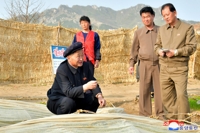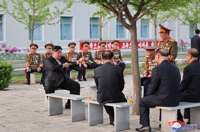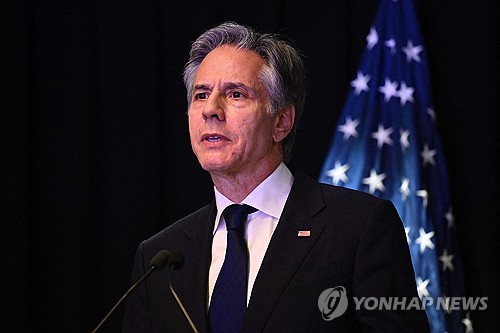(5th LD) Two Koreas reach key agreement to reduce military tensions
(ATTN: RECASTS lead, para 9; ADDS info in para 6, 13)
SEOUL/PYONGYANG, Sept. 19 (Joint Press Corps-Yonhap) -- The two Koreas agreed Wednesday to set maritime, air and ground buffer zones in front-line areas as part of efforts to reduce military tensions, prevent accidental clashes and build trust.
They also agreed to halt military drills near the military demarcation line (MDL), withdraw some border guard posts, disarm the Joint Security Area in the Demilitarized Zone (DMZ) and jointly excavate war remains in the buffer zone.
These measures are included in the agreement that Defense Minister Song Young-moo and his North Korean counterpart, No Kwang-chol, signed after the Pyongyang summit between President Moon Jae-in and North Korean leader Kim Jong-un.
The agreement is part of efforts to flesh out the military part of the April inter-Korean summit accord that calls for halting "all hostile acts" against each other and "practically eliminate the danger of war."
A joint military committee will be operated to check the enforcement of the agreement.
"(The two sides) have decided to completely halt all hostile acts in all spaces, land, sea and air, and agreed on concrete measures to implement the decision," Seoul's defense ministry said in a press release.
Under the agreement, the two Koreas will set up a 10-kilometer-wide buffer zone with the MDL as the standard line. Within the zone, artillery drills and regiment-level field maneuvers will be suspended. The two sides have exchanged fire along the border 96 times since the armistice was signed, halting the Korean War in 1953.
They will also set a maritime buffer zone spanning around 80 km in the East and West Seas to prevent unintended naval clashes. In the zone, artillery firing and naval drills will be suspended, while routine patrol operations near the Northern Limit Line, a de facto maritime border, and efforts to protect fishing activities will continue.
To prevent accidental aircraft clashes, the two sides will set a 40 km-wide no-fly zone along the western part of the MDL and a 80 km-wide one along the eastern side. But they set exceptions for emergencies, such as when aircraft need to be used to extinguish wildfires or transport patients.
To transform the DMZ into a "peace zone," they will each pull out 11 guard posts on a trial basis by the end of this year and halt drills targeting each other near the MDL starting Nov. 1.
They will start a monthlong process to disarm the JSA following a 20-day landmine removal operation set to begin Oct. 1.
The joint project to retrieve war remains in the DMZ is set to take place in Cheorwon, Gangwon Province, from April 1, 2019, to Oct. 31 following the removal of landmines and other explosives later this year.
The two Koreas, in addition, agreed to devise military measures to jointly use the Han River estuary where civilian access has been restricted due to inter-Korean tensions.
While announcing the outcome of his summit with Kim, Moon said that the two Koreas had agreed to remove "all threats across the peninsula" that could trigger war.
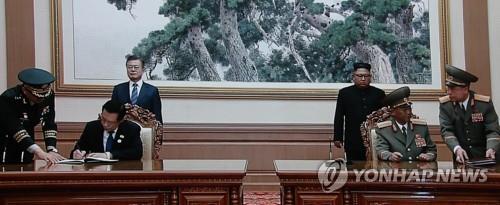
Defense Minister Song Young-moo (L) and his North Korean counterpart, No Kwang-chol, sign an agreement on reducing tensions in Pyongyang on Sept. 19, 2018, in this photo captured from a screen at the press center in Seoul. (Yonhap)
sshluck@yna.co.kr
(END)
-
 'Queen of Tears' weaves rich tapestry of Korean contemporary art
'Queen of Tears' weaves rich tapestry of Korean contemporary art -
 Ateez member Yunho throws first pitch at MLB match between Dodgers, Mets
Ateez member Yunho throws first pitch at MLB match between Dodgers, Mets -
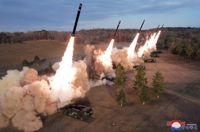 N. Korea says Kim guided simulated nuclear counterattack drills for 1st time
N. Korea says Kim guided simulated nuclear counterattack drills for 1st time -
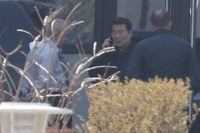 N. Korea calls envisioned U.S. aid to Ukraine 'hallucinogen'
N. Korea calls envisioned U.S. aid to Ukraine 'hallucinogen' -
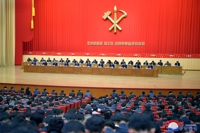 N. Korea calls on party propaganda officials to work harder
N. Korea calls on party propaganda officials to work harder
-
 'Queen of Tears' weaves rich tapestry of Korean contemporary art
'Queen of Tears' weaves rich tapestry of Korean contemporary art -
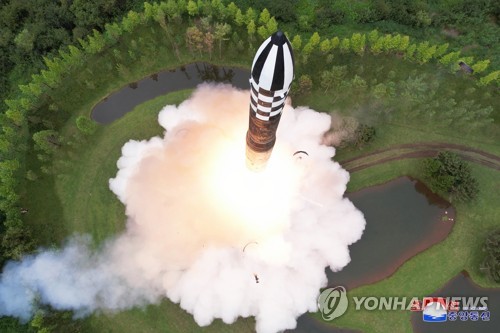 Experts see possibility of N.K. conducting nuclear test before U.S. presidential vote
Experts see possibility of N.K. conducting nuclear test before U.S. presidential vote -
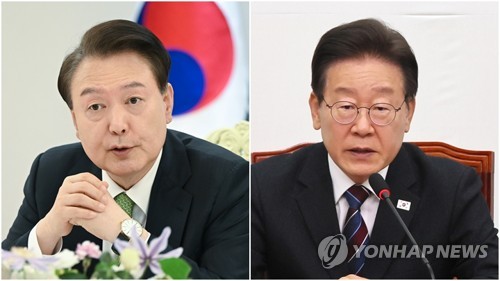 Details of meeting between Yoon, opposition leader undecided: presidential office
Details of meeting between Yoon, opposition leader undecided: presidential office -
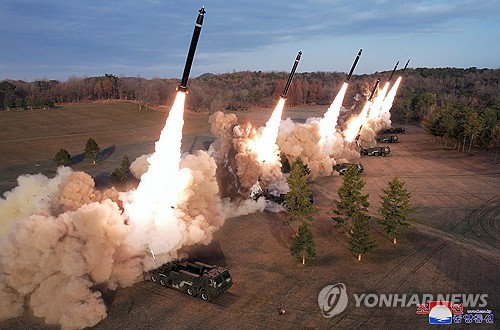 N. Korea says Kim guided simulated nuclear counterattack drills for 1st time
N. Korea says Kim guided simulated nuclear counterattack drills for 1st time -
 Looming weekly closure of major hospitals feared to worsen medical service crisis
Looming weekly closure of major hospitals feared to worsen medical service crisis
-
 S. Korea eliminated in Olympic football qualifiers as poor defense, undisciplined play prove costly
S. Korea eliminated in Olympic football qualifiers as poor defense, undisciplined play prove costly -
 Indonesia coach left with mixed feelings after eliminating native S. Korea in Olympic football qualifiers
Indonesia coach left with mixed feelings after eliminating native S. Korea in Olympic football qualifiers -
 10-man S. Korea lose to Indonesia to miss out on Paris Olympic football qualification
10-man S. Korea lose to Indonesia to miss out on Paris Olympic football qualification -
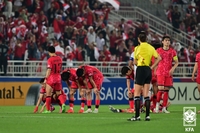 (LEAD) 10-man S. Korea lose to Indonesia to miss out on Paris Olympic football qualification
(LEAD) 10-man S. Korea lose to Indonesia to miss out on Paris Olympic football qualification -
 ADOR CEO calls conflict with Hybe 'worst experience of my life'
ADOR CEO calls conflict with Hybe 'worst experience of my life'
















